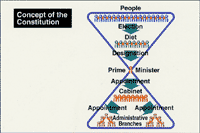Gist of the Central Government Reform
I. Establishing a System with More Effective Political Leadership

To strengthen the administrative leadership of the Cabinet and Prime Minister, the reform
- introduced new positions in the Cabinet Secretariat;
- established a new Cabinet Office;
- created Ministers for Special Mission;
- set up Councils of important policies, such as the Council on Economic and Fiscal Policy;
- placed new politically appointed positions, State Secretary and Parliamentary Secretary, within each Ministry.
II. Restructuring of National Administrative Organs

- Currently 1 Office and 22 Ministries were reorganized into 1 Cabinet Office and 12 Ministries by realigning the roles of the government.
- Policy coordination on issues that concern two or more Ministries will become more effective by the comprehensive coordination of the Cabinet Office which is given higher status than other Ministries.
III. More Transparent Administration

89 undertakings of the government such as the operation of national museums and research institutes are now conducted by IAIs (Independent Administrative Institutions) which are organizationally independent from the government. The establishment of 59 IAIs has been legislated, and most of them will start operating from April 1, 2001. In the IAI system,
- its performance is evaluated by a third party;
- the general principles of the accounting system of private companies are incorporated;
- a wide range of its information is disclosed;
- each employee's salary reflects his/her performance as well as the performance of each IAI.
IV. Drastic Streamlining of the Central Government

- A goal is set to cut the number of national civil servants by 25% over the decade.
- The number of bureaus is reduced from 128 to 96 (by 25%) and that of divisions from approximately 1200 to 1000 (by 20%).
Back to Index
